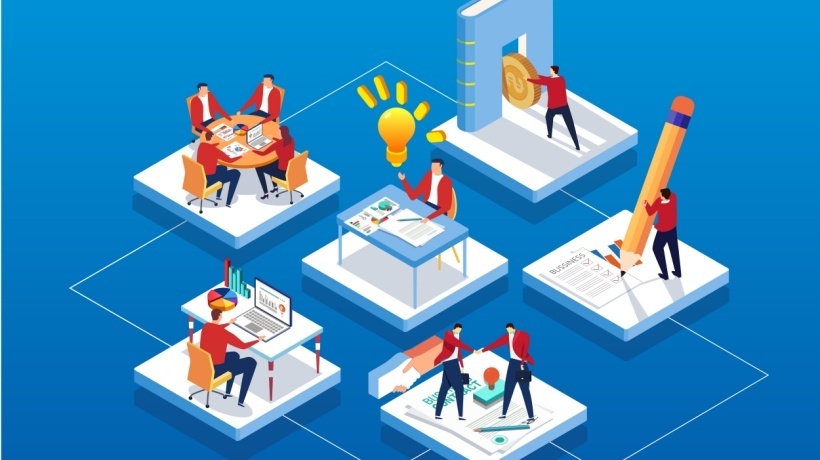Making Learning Work
When we think about helping people to do their jobs well, it seems natural to start with the premise that learning is necessary and should always come first.
After all, we have traveled this road from our childhood.
Most of us attended school from an early age. The objective of schooling of all kinds is to help children gain knowledge and skills, and to develop behaviors that will allow us to navigate our way in life. Schooling does this through structured curricula and a series of ‘gates’ or tests.
Once we reach a certain age and pass the required tests, we might move on to further schooling within college or university. On completing our assessments and gaining our qualifications there we can then set out to find a job where we can apply ourselves in our chosen careers.
This seems an almost natural process. We learn first and then we work. A huge global industry has built up around this approach.
But we are coming to the realization that in the context of organizational learning and learning organizations this is not the only, or necessarily the best, way to create high performing people and teams.
The Learn-Then-Work Behemoth
The fact that learn-then-work is still the standard approach is clearly demonstrated in the behemoth that is the global corporate training market.
No-one knows the size of the training industry for sure, but it has been estimated that more than US$300 billion is spent annually on training and development[1] across the globe. In the USA alone it is estimated the market will grow at a CAGR of 7.8% in terms of revenue over the period 2014-2019[2]. This figure is probably a conservative estimate when compared with the 14% upward trajectory reported for 2015 alone by Training magazine.
There is no doubt the training industry is deeply embedded in organizations’ mindsets and practices, and in their budget planning.
The obvious question that this situation raises is whether the learn-then-work approach is the best, the most efficient, the most effective, and the most fit-for-purpose approach for today’s world.
It seems it isn’t.
Are We Getting Value From Training?
There is little evidence of the benefits gained from much of the expenditure on training. Where evidence does exist, there is a suggestion that considerable inefficiency and loss occurs during the transfer of learning into the workplace.
The fact that the two processes – learning and work– are separated is alone a major cause of inefficiency.
Training transfer losses don’t occur where training and work are one-and-the-same.
Humans are ‘forgetting machines’ and without the opportunity to put learning into practice almost immediately we often find the new things we’ve learned are forgotten within a very short time. Even if we have absorbed the new learning, it is likely that we’ll need extra support as we apply it in our day-to-day work. No-one has total recall from a training or development session, and we rarely return to our class notes or workbooks to help us when we falter in the workplace.
If we remove the need for transfer as much as possible by bringing learning and work together, the problem is, essentially, removed.
Training Failures
Apart from simply forgetting what we’ve learned, there are other reasons for the sub-optimal results produced by many training initiatives.
Take, for instance, the giant industry that comprises general diversity and compliance training.
Most organizations invest heavily in both these often because government or industry regulators demand they do so. Yet studies suggest that both fail to deliver expected results,
In his HBR article[3] ‘Diversity Training Doesn’t Work’, Peter Bregman reported a meta-study of 829 companies over 31 years which showed that diversity training had “no positive effects in the average workplace”. Attitudes and the diversity of the organizations remained the same. The study, carried out by Frank Dobbin of Harvard, Alexandra Kalev of Berkeley, and Erin Kelly of the University of Minnesota[4], in fact reported findings that were more damning than that.
With more than 16,000 data points (each being a workplace in a specific year) the researchers examined more than 60 workplace characteristics that might affect diversity. They found that training did not, on average, increase diversity and, in some cases (the number of African American women in management roles is an example) diversity training was negatively correlated with diversity behaviors and culture. In other words, training actually decreased diversity behaviors rather than increased them!
Yet this shouldn’t be a surprise. Psychology research and field studies have shown that it is difficult to train away stereotyping[5], and that training sometimes elicits a backlash.
Dobbin, Kalev and Kelly conclude “Overall, companies that try to change managers’ behavior through training and evaluations have not seen much change. That is disappointing, because training is the single most popular program and, by most accounts, the most costly, and because many companies have put their money on diversity evaluations in recent years”.
Learning away from work creates problems not only of failure to remember, but also of failure with opportunities to apply in the exact content of the workplace into the training environment.
Doing Things Differently - Embedding Learning In Work
Many of the problems with the gap between the intent to improve performance and outcomes of learn-then-work can be overcome by thinking and acting differently.
The transfer of training, and attempting to overcome associated loss of potential value, has been a major focus for Training and Development professionals for many years. Mary Broad and John Newstrom’s seminal 1991 publication[6] ‘Transfer of Training’, reported that active engagement and participation in the development process by the line manager was essential if positive impact was to result. And managers need to do more than simply provide support from the side-lines.
An important basic fact to remember is that the closer learning occurs to the point of use, then the more effective that learning is likely to be.
If we can embed learning as part of daily work, and extract learning from daily work, we are much better placed to build high performing organizations.
Learning And Working Together
Broad and Newstrom’s research, and the work of many other researchers, has shown that the learning which occurs as part of the daily flow of work is more likely to be both more effective and to be retained. Context is critical for learning and behavior change. If we remove people from the context where they need to perform, simply in order to help them prepare to perform, then desired outcomes are less likely to be achieved.
Take, for example, the concept and practice of ‘match fitness’. Ted Gannan, the CEO of performance support company Panviva (a 70:20:10 Institute partner), explains this very well in an article published in March 2016[7] titled ‘Do your employees have match fitness?’.
In this article, Gannan points out that ‘Formal training is not sufficient to prepare anyone for the job – they need to be able to put the knowledge and skills from training into action in ‘match conditions’ before they can hope to achieve true competence’. He goes further to suggest that it can be dangerous and detrimental to overall team performance to expect someone to learn-then-work without the necessary support and opportunity to apply new skills and capability in the context of the workflow.
When we integrate learning with work, or integrate learning with performance, then the outcome is far more likely to meet expectations.
Learning From Work
One of the major shifts in mindset and practice that needs to occur if we are to build agile, responsive, and high-performing workforces is the evolution from learn-then-work (the training paradigm) to learn-from-work (the performance paradigm).
Learning from work requires new mindsets, but it overcomes the challenge of the ‘learning-doing gap’ and many of the learning transfer pitfalls.
If we are to make learning work and integrate learning into the workflow, one of the major mindset changes that must be addressed is one held by many leaders and managers – that operational excellence is their priority and that developing their people is the job of the HR and Training/Learning departments.
Leaders and managers need to place equal emphasis on both operational emphasis and developing their people. One cannot become subservient to the other if a resilient culture of high performance is the objective.
Summary: Shifts To Enable Learning From Work
There are several major changes required to exploit the new performance paradigms such as 70:20:10 and build high performing individuals, teams, and organizations.
Leaders and managers must understand that there can be no trade-off between operational excellence (usually short-term, tactical) and building a high performing workforce (strategic and longer-term). Both are necessary for sustainability and both are the prime jobs of what being a leader or manager is all about.
- Financial managers must understand that just because a project has a ‘training line’ in the financial plan it doesn't mean that people will be well prepared to adopt/deploy/use whatever the project is delivering if training alone is undertaken.
- HR managers must re-think some their processes – annual objective setting, individual development plans, learning paths etc. to better reflect a culture of enabling learning from work.
- Individuals must take responsibility for their own development in conjunction, with support from their organization and their leaders, and develop both mindsets and expertise in the practice of learning from work.
The starting point for these changes is the understanding that if we are to build and support high performance we need to think and act differently. Within the 70:20:10 context we call this ‘planning for the 100 and starting from the ‘70’’.
This means that whenever we are looking to improve the way people work and deliver on their objectives, we need to think ‘how can we exploit learning from work (the ‘70’ and ’20)?’ first, rather than ‘how can we train people to work (the ‘10’)?’.
Footnotes:
- TrainingIndustry.com 2014 estimates.
- Corporate Training Market in the US 2015-2019 report, Technavio Market Research.
- Bregman, P., hbr.org 2012. Diversity Training Doesn’t Work
- Dobbin, F., Kalev, A., and Kelly. E. Diversity Management in Corporate America. Contexts, Vol. 6, Number 4, pp 21-27. The American Sociological Association.
- ibid
- Broad, M.L, and Newstrom, J.W. (1991) Transfer of Training. Perseus. ASIN: B011T7BDZS
- CEO’s Desk: L&D lessons from Australian rules football









